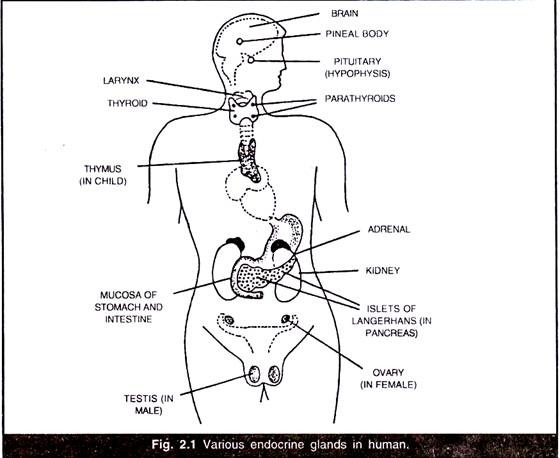The human body has two interdependent integrating systems in the body, called nervous and endocrine systems.
The endocrine system consists of endocrine glands or ductless glands which integrate the body functions by releasing Chemical Messengers or autocoids or hormones. Thomas Addison is called as the father of endocrinology.
The secretory organs of the body are called as glands. Two types of glands are found in the body of multicellular organisms, viz., exocrine glands and endocrine glands.
The exocrine glands deliver their secretions by means of ducts. Sebacious glands of skin, salivary glands of buccal cavity, gastric glands of stomach, glands of intestine and liver are common examples of exocrine glands.
The second type of gland secretes active chemical substances directly into blood without the help of any duct and are known as endocrine glands or ductless glands. All the endocrine glands of the body taken together constitute ‘Enodocrine system’ and the branch of science which deals with the study of endocrine glands is said to be “ENDOCRINOLOGY” (Gr. endon-within; krinien-separate; logos-study).
There is a third kind of gland consisting of both exocrine and endocrine tissues. The secretion of exocrine part is carried by ducts and the secretion of endocrine part is carried by blood. This type of gland is termed as heterocrine gland. Pancreas and gonads are heterocrine glands.
Endocrine Glands (Coloured Plate-Vi-Vii):
The endocrine system in vertebrates consists of the following endocrine glands some of which are heterocrine i.e. partly endocrine and partly exocrine (Fig. 2.1).
1. Pituitary (one)
2. Thyroid (one)
3. Parathyroid (Four)
4. Adrenals or Supra-renal glands (2)
5. The Islets of Langerhans in pancreas (Heterocrine)
6. Testes in males (2) (Heterocrine)
7. Ovaries in females (2) (Heterocrine)
8. Placenta in female
9. Thymus (one)
10. Pineal body (one)
11. Gastro intestinal mucosa (heterocrine)
